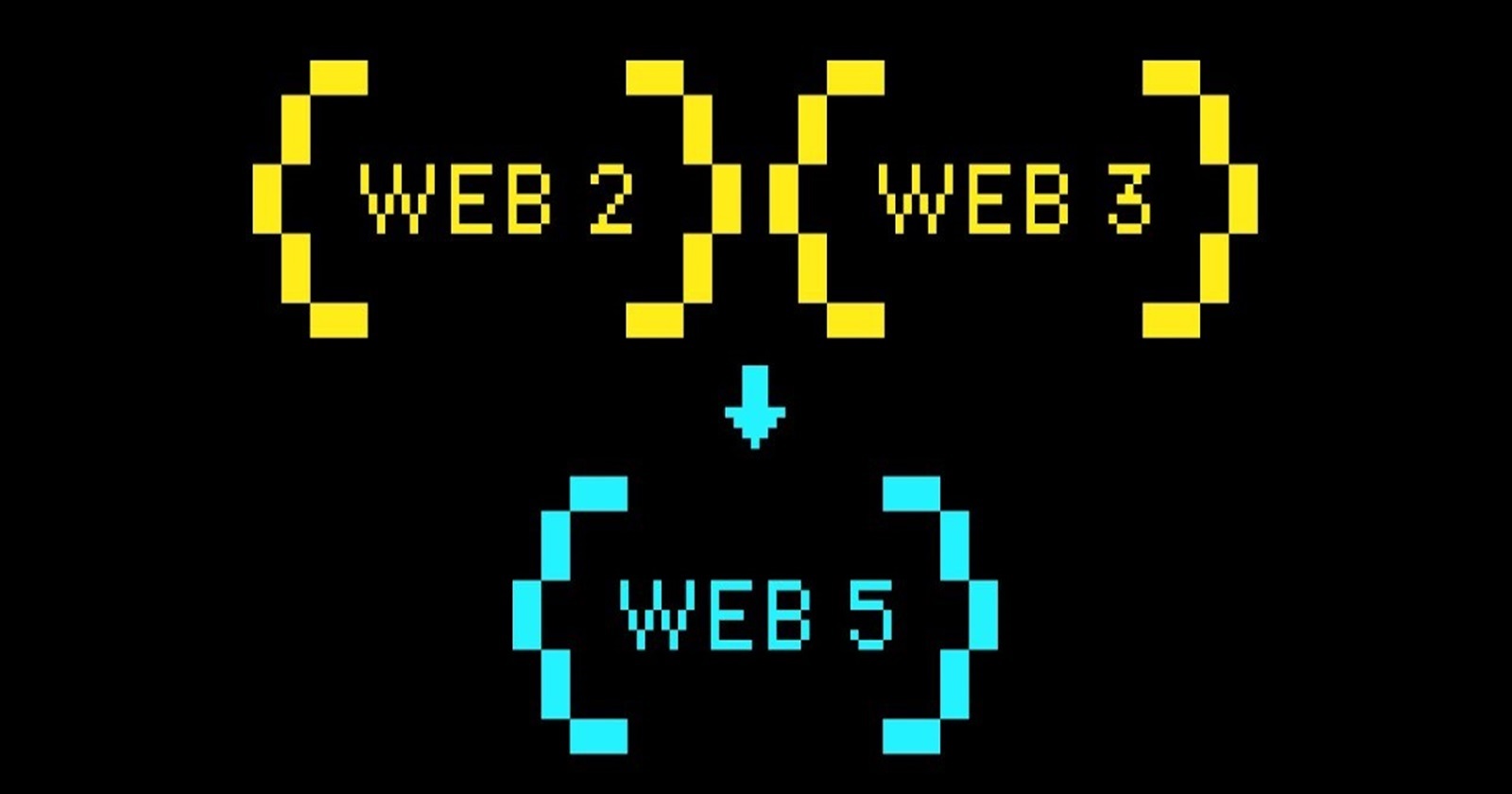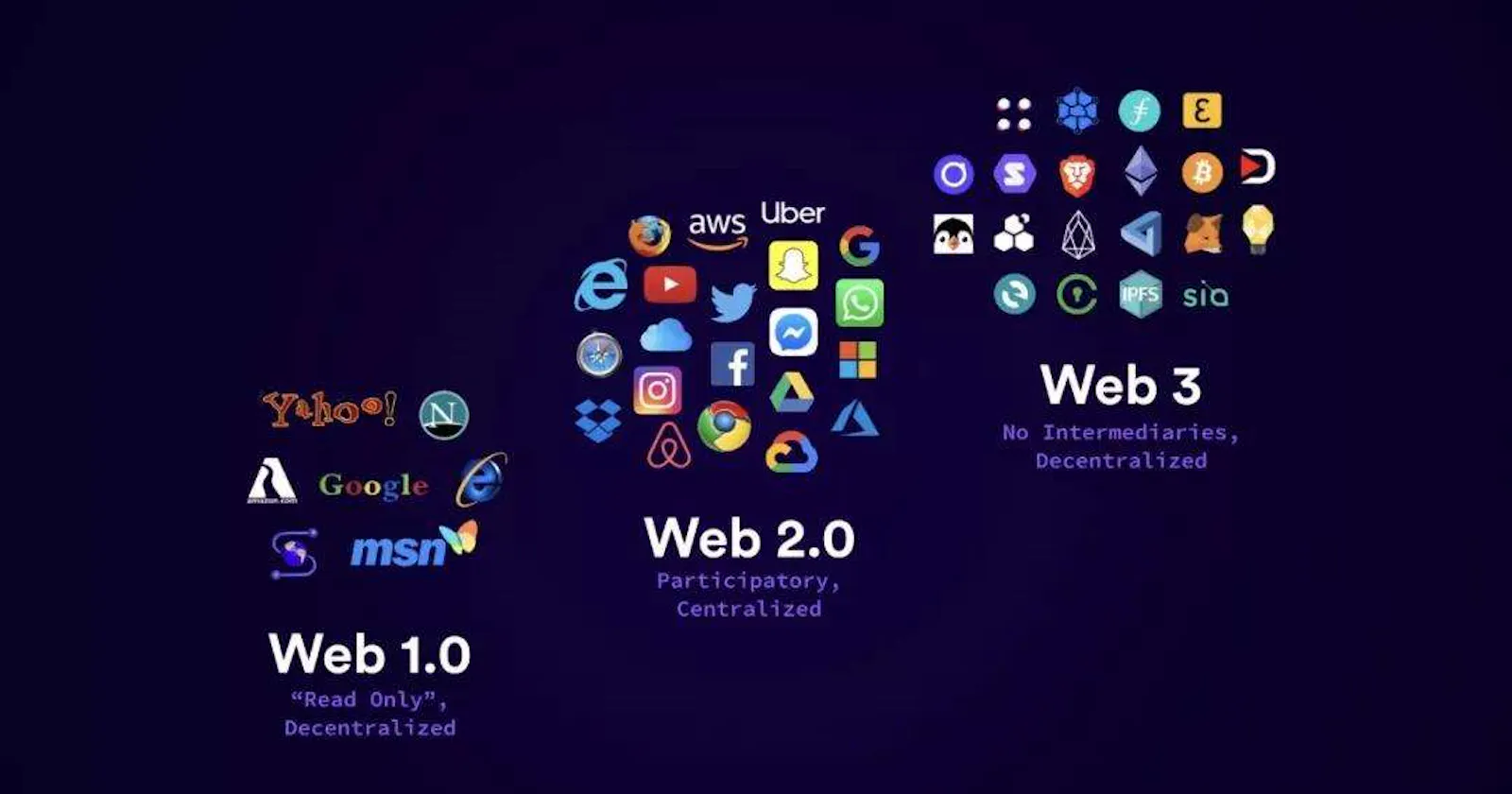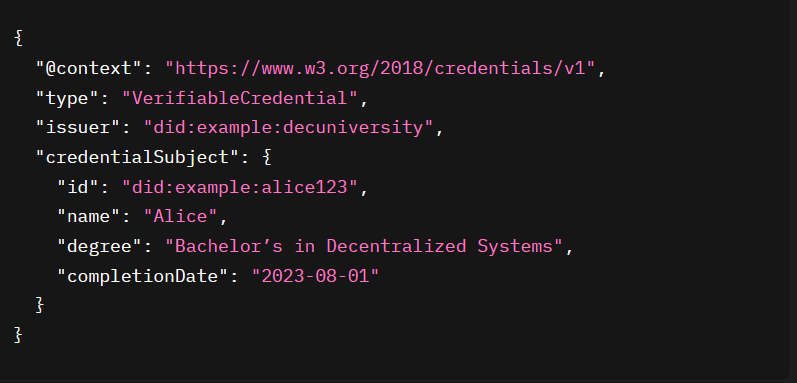Web5 Unveiled: A Symphony of User Empowerment and Decentralization
 Favour Markson
Favour Markson
Introduction
Imagine Web2 and Web3 as distinct elements – Web2, the practical creator building easy-to-use websites and online spaces. This is like the internet we're familiar with today and Web3, the creative explorer pushing the boundaries of decentralized possibilities. It's like an artist experimenting with new ways to organize and share information online. Now, envision Web5 as the magical combination of these two approaches into a powerful potion of technological evolution. In simpler terms, Web5 is the lovechild of Web2 and Web3, the best of both worlds, inheriting the user-friendly charm from its ancestor and the rebellious spirit of decentralization from its predecessor.
This convergence wasn't just a natural progression; it was ignited by the visionary mind of Jack Dorsey, the co-founder and former CEO of Twitter as well as co-founder, principal executive officer, and chairperson of Block, the parent company of Square, and a trailblazer in the tech industry. Jack identified the limitations of Web2, where user data is scattered across multiple services, raising privacy concerns, and limiting user control. While Web3 introduced decentralized identities and blockchain technology, Jack envisioned an even more ambitious solution – Web5. This innovative iteration combines Web2's familiar services and Web3's advanced technology, all woven together on the robust foundation of the Bitcoin blockchain.
Web5 isn't merely an upgrade; it's a convergence brought to life by Jack Dorsey's insight and determination. It stands as a testament to the dynamic nature of technological evolution, where visionary leaders like Jack continually push the boundaries of possibility. Fasten your digital seatbelts; the harmonious convergence is here, and it's time to explore the extraordinary collaboration between the pragmatic and avant-garde in the domain of Web5. Welcome to the future, where technology doesn't just advance; it harmonizes.
My Journey into Web5: Embracing the Convergence

Angie Jones, the Head of Developer Relations a TBD, Block’s new business unit, delivering a keynote Speech on Web5 at the Open Source Festival 2023 in Lagos, Nigeria.
My journey to Web5 began at the Open Source Festival, 2023 (OSCAFEST23) in Lagos Nigeria, where Angie Jones, the Head of Developer Relations for TBD, Block’s new business unit focused on decentralized technologies, unveiled the revolutionary potential of Web5. As Angie eloquently presented, the web was initially invented to decentralize communications, allowing anyone to publish information worldwide without the approval of a central entity. However, the missing identity layer posed challenges, leading to the collection of user information by applications for persistence.
Angie shared the transformative concept of Web5, which empowers users to own and control both their identity and data across the web. The presentation delved into the core pillars of Web5: Decentralized Identifiers (DIDs), Verifiable Credentials, and Decentralized Web Nodes (DWNs). DIDs, following W3C standards, provide users with unique identifiers not controlled by intermediaries. Verifiable Credentials enable trustless interactions, allowing claims about a user to be verified without mutual trust. The introduction of Decentralized Web Nodes was particularly intriguing, as it liberates users from relying on centralized entities to store their data, providing a more user-centric approach.
Angie illustrated how Web5 offers a revolutionary shift in user experience, emphasizing a "bring your own data" model. Users can hold their data in personal data stores, replicating across devices and providing true data portability. The presentation showcased practical applications, such as a decentralized Spotify experience and secure management of medical records.
Eager to explore this groundbreaking technology further, my curiosity led me to delve deeper into Web5. Intrigued by Angie Jones' presentation at OSCAFEST23, I sought more information to better understand the distinctive features of Web5 in comparison to Web3. Turning to YouTube, I watched several videos that provided insightful explanations, helping me grasp the nuances that set Web5 apart.
I visited the official TBD developer website to gain a more comprehensive understanding. Here, I found valuable resources that offered a detailed view of Web5's architecture, functionalities, and potential applications. The site served as a comprehensive guide, providing clarity on how Web5 integrates Web2's services with Web3's advanced technology, all on the secure foundation of the Bitcoin blockchain.
Eager to put my newfound knowledge into practice, I embarked on a hands-on experience by creating records and experimenting with CRUD operations on a decentralized web node. This practical project not only solidified my understanding of Web5 but also highlighted its user-friendly approach, emphasizing its potential for developers to craft decentralized applications easily
Exploring the Decentralization of Web 5

The internet has continuously evolved, from the static, read-only nature of Web1 to the interactive, user-generated content of Web2, the groundbreaking decentralization of Web3. Today, we stand at the precipice of another transformative era – the emergence of Web5 (Web2 + Web3).
Diverging Paths: Web3 vs. Web5
While both Web3 and Web5 champion decentralization, their focus and approach mark distinct paths in digital evolution. Web3, the trailblazer, brought decentralization to the forefront, emphasizing control distribution across a peer-to-peer network. It laid the groundwork for a trustless and tamper-resistant digital landscape through technologies like blockchain. In contrast, Web5 is a new paradigm that builds upon the concepts of Web2 and Web3. It emphasizes user empowerment and takes decentralization to a new level. Web5 enables individuals to reclaim their personal data, exercise greater control over their online presence, and actively shape the future of the web. It fosters a more inclusive and democratic online ecosystem, where users have the freedom to choose, customize, and contribute to their online experiences in unprecedented ways. Web5 recognizes that decentralization alone isn't enough; it's the marriage of decentralization with user empowerment that sets it apart.
Key Technologies of Web5
Web5 seamlessly integrates three fundamental pillars, each rooted in open standards, forming the backbone of this revolutionary decentralized web platform:
Decentralized Identifiers (DIDs):
Ownership and Control: Unlike traditional identifiers owned by intermediaries, DIDs empower users with self-owned identifiers, eliminating dependence on centralized entities for authentication.
W3C Standard: DIDs adhere to the W3C standard, featuring a structured format comprising a URI scheme identifier, DID method, and DID method-specific identifier.
ION Integration: Web5 prioritizes the use of ION, a Layer 2 DID network atop Bitcoin, for anchoring DIDs, offering a decentralized alternative to DNS for identity identifiers.
Below is an example of a Decentralized Identifier.

Verifiable Credentials:
Trustless Interactions: Verifiable Credentials, a ratified W3C standard, work synergistically with DIDs, allowing trustless interactions where claims about a DID subject can be cryptographically verified.
Use Case Example: A scenario involving Acme Bank issuing a Verifiable Credential to Alice's wallet, proving her account details without the need for mutual trust.
A VC is represented as JSON objects so that they're easy to work with programmatically across various systems. Here's an example VC:

Decentralized Web Nodes (DWNs):
Data Decoupling: DWNs revolutionize data storage by allowing users to host their data independently, breaking free from centralized application servers.
BlueSky As an Example: BlueSky, a decentralized Twitter alternative, illustrates how tweets and connections are stored locally, granting users control over their content.
Universal Addressing: DWNs support universally addressable, replicated, and secure storage, enabling a diverse range of decentralized apps and protocols.
Example Application - Health Data Management
Consider a scenario where individuals manage their health data through Web5*:*
Decentralized Health Records
Ownership: Users store their health records as JSON objects in their DWNs, ensuring data ownership and control.
Privacy: Sensitive information, such as medical history and test results, remains encrypted and private, accessible only with user-granted permissions.
Verifiable Health Credentials
Medical Certifications: Healthcare providers issue Verifiable Credentials containing medical certifications, allowing users to share their verified health status selectively.
Trustless Verification: Institutions and apps, relying on the credibility of healthcare providers, can securely verify users' health credentials without direct trust relationships.
Personal Health Assistant
Decentralized App: Developers leverage Web5 to create a decentralized health management app that interfaces with users' DWNs.
User Empowerment: Users have a seamless and secure way to manage, share, and update their health data across different medical services and applications.
The Evolution Continues: Distinguishing Features of Web5
As I explored the distinctive features that distinguish Web5, it became evident that this iteration isn't just an incremental upgrade; it's a holistic reimagining of the digital frontier. Users don't just contribute data; they emerge as empowered architects of their digital presence.
| Feature | Web2 | Web3 | Web5 |
| Data Ownership | Centralized platforms control user data | Users own and control their data | Users own and control their data, with additional layers of privacy and security |
| Data Privacy | User privacy is often compromised | Data privacy is prioritized through encryption and secure protocols | Data privacy is further enhanced through decentralized identity management and zero-knowledge proofs |
| Interoperability | Limited interoperability between platforms | Seamless interoperability between decentralized applications (DApps) | Seamless interoperability across DWAs, DApps, and traditional web applications |
| Governance | Centralized governance by platform owners | Decentralized governance through token holders and community consensus | Decentralized governance with enhanced user participation and control |
| Monetization | Platforms monetize user data | Users monetize their own data and contributions | Users monetize their data, contributions, and interactions in a more transparent and equitable manner |
| Technology | Client-server architecture | Blockchain technology | Distributed web nodes (DWNs) and semantic web technologies |
| User Experience | Read-write web focused on user-generated content | Read-write-execute web, with decentralized applications and services | Intelligent and user-centric web, with personalized experiences and |
| Applications | Social media platforms, e-commerce, cloud storage | Decentralized finance (DeFi), non-fungible tokens (NFTs), decentralized autonomous organizations (DAOs) | Decentralized social networks, data marketplaces, decentralized identity management |
| Impact | Monetization of user data, centralized control | User empowerment, data ownership, decentralized governance | Enhanced privacy, personalized experiences, seamless interactions |
In conclusion, my journey of discovery from hearing about Web5 at OSCAFEST23 to hands-on exploration has illuminated the profound impact of this emerging technology. Web5 is not merely a technological advancement; it symbolizes a pivotal shift towards user empowerment and data ownership in the decentralized landscape.
As I delved into the Tech Preview of Web5, the promise of a paradigm shift in the web landscape became evident. Its foundation on open standards and the enthusiastic collaboration within the community has fueled my anticipation for the transformative possibilities that lie ahead. The future of Web5 remains to be defined, and the evolution of technology is on the brink of a harmonious convergence within its domain.
How to Get Involved
As Web5 continues to redefine the web landscape, there are various ways to contribute:
GitHub Contributions: Explore and contribute to TBD Web5's GitHub projects, addressing ongoing challenges and evolving the platform.
Collaboration: If your company shares the vision of decentralized technologies or could benefit from Web5 components, consider collaboration.
Community Engagement: Join the TBD Web5 community on Discord to connect with like-minded enthusiasts and stay updated on the latest developments.
Web5 invites individuals, companies, and visionaries to actively participate in shaping the decentralized future of the web.
I sincerely hope that this article has provided valuable insights into the essence of Web5 and the compelling reasons to embark on the journey now. As we stand at the threshold of this decentralized revolution, embracing Web5 is not just about adopting new technology; it's about embracing a future where users have unprecedented control and ownership of their digital experiences. The time to get started is now, and the possibilities are boundless. Web5 invites you to join in shaping the future of the web—one that empowers individuals fosters trustless interactions, and opens the door to a decentralized era.
References
TBD. (2023). Developers | TBD. Developer.tbd.website. Retrieved November 28, 2023, from https://developer.tbd.website/
Abati, A. (2023). Web5 - A simplified look into becoming a walking Human API #web5. Www.youtube.com. Retrieved November 28, 2023, from https://youtu.be/0BvU0nC2BcM?si=Ak2Fz8ThF80Nzseu
Telusko. (2023). Web5 is Here | Web2 + Web3. Www.youtube.com. Retrieved November 28, 2023, from https://youtu.be/HDhBbLnlenE?si=XcdadS-azXovQjJT
Subscribe to my newsletter
Read articles from Favour Markson directly inside your inbox. Subscribe to the newsletter, and don't miss out.
Written by

Favour Markson
Favour Markson
As a seasoned backend engineer, I bring a robust skill set rooted in server-side development and database design. My expertise lies in backend development, with a specialization in Node.js and Django. I am committed to innovative problem-solving and thrive in diverse project environments, showcasing adaptability as a key strength. My track record demonstrates excellent team building and management skills, underlining a proven success in leading and coordinating efforts.